译林牛津版 8AUNIT8 Natural disaster Task 教学课件 (共20张PPT)
- 格式:ppt
- 大小:2.04 MB
- 文档页数:20
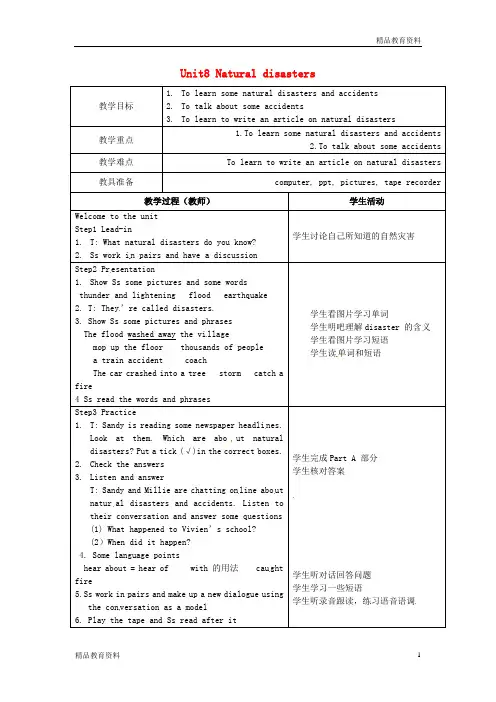
Unit8 Natural disasters教学目标1.To learn some natural disasters and accidents2.To talk about some accidents3.To learn to write an article on natural disasters教学重点1.To learn some natural disasters and accidents2.To talk about some accidents教学难点To learn to write an article on natural disasters 教具准备 computer, ppt, pictures, tape recorder 教学过程(教师)学生活动Welcome to the unitStep1 Lead-in1.T: What natural disasters do you know?2.Ss work i n pairs and have a discussion学生讨论自己所知道的自然灾害Step2 Pr esentation1.Show Ss some pictures and some wordsthunder and lightening flood earthquake2. T: They’re called disasters.3. Show Ss some pictures and phrasesThe flood washed away the vi llagemop up the floor thousands of peoplea train accident coachThe car crashed into a tree storm catch a fire4 Ss read the words and phrases 学生看图片学习单词学生明吧理解disaster 的含义学生看图片学习短语学生读单词和短语Step3 Practice1.T: Sandy is reading some newspaper headli nes.Look at them. Which are abo ut naturaldisasters? Put a tick (√)in the correct boxes.2.Check the answers3.Listen and answerT: Sandy and Millie are chatting on line abo ut natur al disasters and accidents. Listen to their conversation and answer some questions(1) What happened to Vivien’s school?(2)When did it happen?4. Some language pointshear about = hear of with 的用法 cau ght fire5.Ss work in pairs and make up a new dialogue usingthe con versation as a model6. Play the tape and Ss read after it 学生完成Part A 部分学生核对答案学生听对话回答问题学生学习一些短语学生听录音跟读,练习语音语调Comic stripStep1 Presentation1.Listen to the conversation and answer questions(1)What’s the weather like?(2)What happened to Ho bo?(3)What was Hobo doing when it started to rain?(4)Did Hobo hear the rain?(5)Why doesn’t he want to go home alone?(6)What do you think of Hobo?2.Some language pointswake up 醒来wake sb. up 叫醒某人mop up 拖干,把......拖干fall from 从……掉下,落下学生听对话回答问题学生学习相关语言点Step 2 Practice1.Act the comic strip out2. Finish some exercises on the ppt 学生表演对话学生完成ppt上的相关练习Step3 Homework1.Write an article about the natural disaster2.Review the words and phrases and some languagepoints3. Preview reading教学反思。
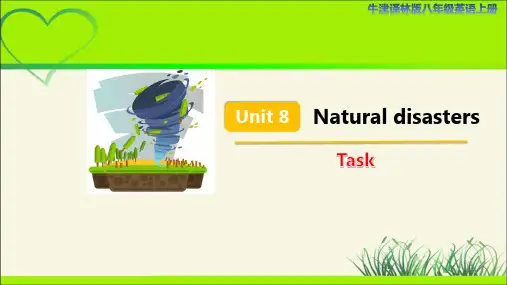
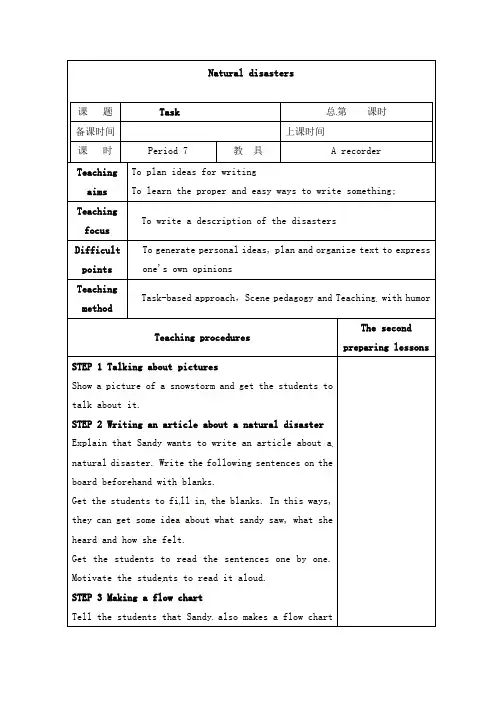
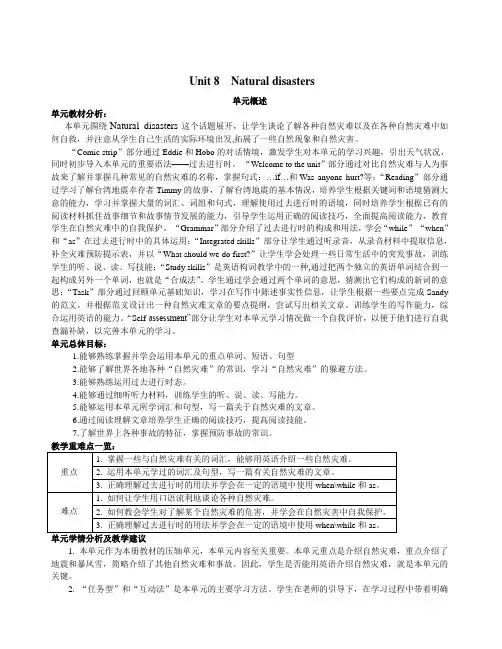
Unit 8 Natural disasters单元概述单元教材分析:本单元围绕Natural disasters这个话题展开,让学生谈论了解各种自然灾难以及在各种自然灾难中如何自救,并注意从学生自己生活的实际环境出发,拓展了一些自然现象和自然灾害。
“Comic strip”部分通过Eddie和Hobo的对话情境,激发学生对本单元的学习兴趣,引出天气状况,同时初步导入本单元的重要语法——过去进行时。
“Welcome to the unit”部分通过对比自然灾难与人为事故来了解并掌握几种常见的自然灾难的名称,掌握句式:…if…和Was anyone hurt?等;“Reading”部分通过学习了解台湾地震幸存者Timmy的故事,了解台湾地震的基本情况,培养学生根据关键词和语境猜测大意的能力,学习并掌握大量的词汇、词组和句式,理解使用过去进行时的语境,同时培养学生根据已有的阅读材料抓住故事细节和故事情节发展的能力,引导学生运用正确的阅读技巧,全面提高阅读能力,教育学生在自然灾难中的自我保护。
“Grammar”部分介绍了过去进行时的构成和用法,学会“while”“when”和“as”在过去进行时中的具体运用;“Integrated skills”部分让学生通过听录音,从录音材料中提取信息,补全灾难预防提示表,并以“What should we do first?”让学生学会处理一些日常生活中的突发事故,训练学生的听、说、读、写技能;“Study skills”是英语构词教学中的一种,通过把两个独立的英语单词结合到一起构成另外一个单词,也就是“合成法”。
学生通过学会通过两个单词的意思,猜测出它们构成的新词的意思;“Task”部分通过回顾单元基础知识,学习在写作中陈述事实性信息,让学生根据一些要点完成Sandy 的范文,并根据范文设计出一种自然灾难文章的要点提纲,尝试写出相关文章。
训练学生的写作能力,综合运用英语的能力。

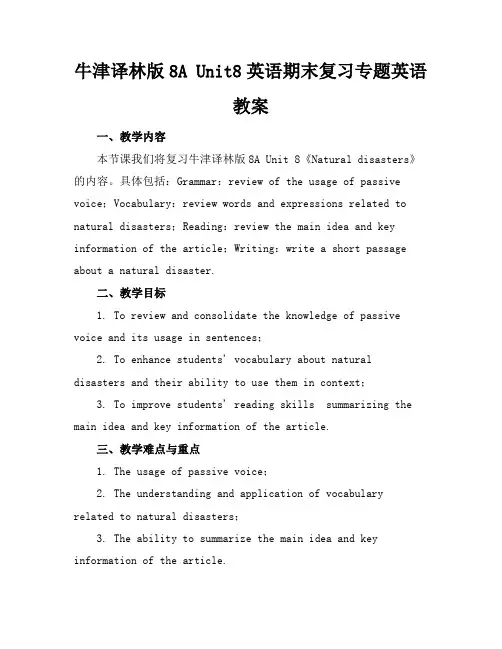
牛津译林版8A Unit8英语期末复习专题英语教案一、教学内容本节课我们将复习牛津译林版8A Unit 8《Natural disasters》的内容。
具体包括:Grammar:review of the usage of passive voice;Vocabulary:review words and expressions related to natural disasters;Reading:review the main idea and key information of the article;Writing:write a short passage about a natural disaster.二、教学目标1. To review and consolidate the knowledge of passive voice and its usage in sentences;2. To enhance students' vocabulary about natural disasters and their ability to use them in context;3. To improve students' reading skills summarizing the main idea and key information of the article.三、教学难点与重点1. The usage of passive voice;2. The understanding and application of vocabulary related to natural disasters;3. The ability to summarize the main idea and key information of the article.四、教具与学具准备1. Blackboard;2. Multimedia projector;3. Handouts with exercises;4. Answer sheets for selfchecking.五、教学过程1. Leadin:Show pictures of different natural disasters and ask students to name them, then elicit the topic of the unit.2. Review of passive voice:Present several sentences about natural disasters and ask students to change them into passive voice. Discuss the usage and rules of passive voice.3. Vocabulary review:Ask students to match the words and expressions related to natural disasters with their definitions. Then have a brainstorming session to see how many words they can recall.4. Reading review:Divide students into groups and ask them to summarize the main idea and key information of the article. Share their answers and discuss as a class.5. Writing practice:Ask students to write a short passage about a natural disaster they have experienced or learned about. Provide them with guiding questions to help structure their writing.6. Oral practice:Pair students up and ask them to discuss the causes and effects of natural disasters. Encourage them to use the vocabulary they have reviewed.六、板书设计1. Passive voice:Rules and examples;2. Vocabulary:List of words and expressions related to natural disasters;3. Main idea and key information of the article.七、作业设计1. Write a short passage about a natural disaster using passive voice;2. Translate the following sentences into English using the vocabulary learned:洪水造成了严重的损失。
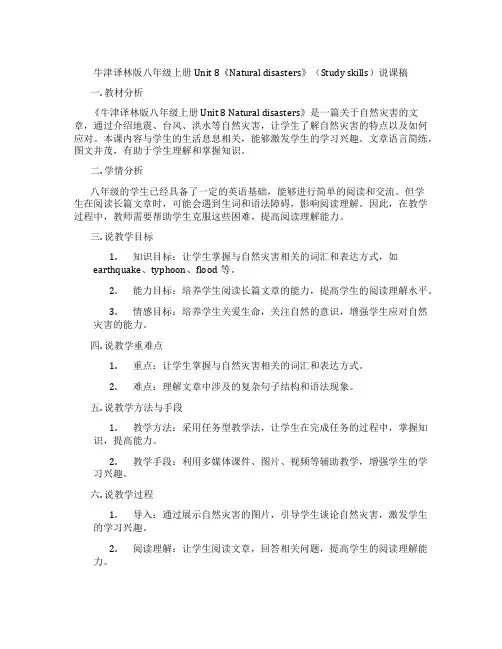
牛津译林版八年级上册Unit 8《Natural disasters》(Study skills)说课稿一. 教材分析《牛津译林版八年级上册Unit 8 Natural disasters》是一篇关于自然灾害的文章,通过介绍地震、台风、洪水等自然灾害,让学生了解自然灾害的特点以及如何应对。
本课内容与学生的生活息息相关,能够激发学生的学习兴趣。
文章语言简练,图文并茂,有助于学生理解和掌握知识。
二. 学情分析八年级的学生已经具备了一定的英语基础,能够进行简单的阅读和交流。
但学生在阅读长篇文章时,可能会遇到生词和语法障碍,影响阅读理解。
因此,在教学过程中,教师需要帮助学生克服这些困难,提高阅读理解能力。
三. 说教学目标1.知识目标:让学生掌握与自然灾害相关的词汇和表达方式,如earthquake、typhoon、flood等。
2.能力目标:培养学生阅读长篇文章的能力,提高学生的阅读理解水平。
3.情感目标:培养学生关爱生命,关注自然的意识,增强学生应对自然灾害的能力。
四. 说教学重难点1.重点:让学生掌握与自然灾害相关的词汇和表达方式。
2.难点:理解文章中涉及的复杂句子结构和语法现象。
五. 说教学方法与手段1.教学方法:采用任务型教学法,让学生在完成任务的过程中,掌握知识,提高能力。
2.教学手段:利用多媒体课件、图片、视频等辅助教学,增强学生的学习兴趣。
六. 说教学过程1.导入:通过展示自然灾害的图片,引导学生谈论自然灾害,激发学生的学习兴趣。
2.阅读理解:让学生阅读文章,回答相关问题,提高学生的阅读理解能力。
3.词汇学习:讲解文章中出现的生词和短语,让学生掌握与自然灾害相关的词汇。
4.语法讲解:分析文章中的复杂句子结构和语法现象,帮助学生理解。
5.小组讨论:让学生分小组讨论如何应对自然灾害,培养学生的合作意识。
6.总结:对本节课的内容进行总结,强化学生的记忆。
7.作业布置:让学生课后写一篇关于自然灾害的短文,提高学生的写作能力。

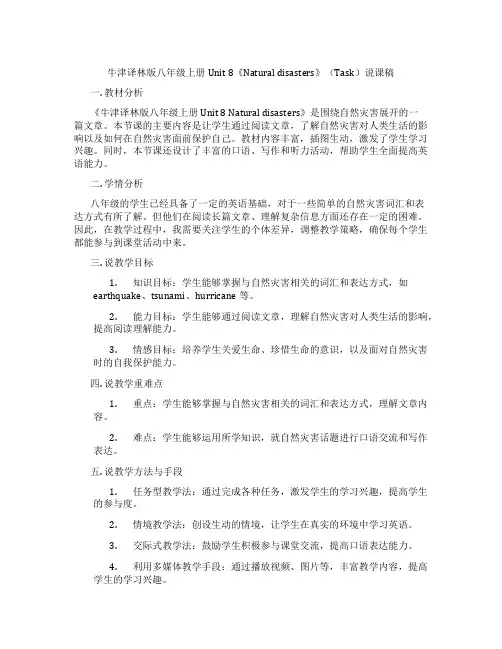
牛津译林版八年级上册Unit 8《Natural disasters》(Task)说课稿一. 教材分析《牛津译林版八年级上册Unit 8 Natural disasters》是围绕自然灾害展开的一篇文章。
本节课的主要内容是让学生通过阅读文章,了解自然灾害对人类生活的影响以及如何在自然灾害面前保护自己。
教材内容丰富,插图生动,激发了学生学习兴趣。
同时,本节课还设计了丰富的口语、写作和听力活动,帮助学生全面提高英语能力。
二. 学情分析八年级的学生已经具备了一定的英语基础,对于一些简单的自然灾害词汇和表达方式有所了解。
但他们在阅读长篇文章、理解复杂信息方面还存在一定的困难。
因此,在教学过程中,我需要关注学生的个体差异,调整教学策略,确保每个学生都能参与到课堂活动中来。
三. 说教学目标1.知识目标:学生能够掌握与自然灾害相关的词汇和表达方式,如earthquake、tsunami、hurricane等。
2.能力目标:学生能够通过阅读文章,理解自然灾害对人类生活的影响,提高阅读理解能力。
3.情感目标:培养学生关爱生命、珍惜生命的意识,以及面对自然灾害时的自我保护能力。
四. 说教学重难点1.重点:学生能够掌握与自然灾害相关的词汇和表达方式,理解文章内容。
2.难点:学生能够运用所学知识,就自然灾害话题进行口语交流和写作表达。
五. 说教学方法与手段1.任务型教学法:通过完成各种任务,激发学生的学习兴趣,提高学生的参与度。
2.情境教学法:创设生动的情境,让学生在真实的环境中学习英语。
3.交际式教学法:鼓励学生积极参与课堂交流,提高口语表达能力。
4.利用多媒体教学手段:通过播放视频、图片等,丰富教学内容,提高学生的学习兴趣。
六. 说教学过程1.导入:以一段关于自然灾害的视频导入,激发学生的学习兴趣。
2.阅读理解:学生阅读文章,回答相关问题,了解自然灾害对人类生活的影响。
3.词汇学习:学生通过小组合作,归纳总结文章中出现的自然灾害词汇。
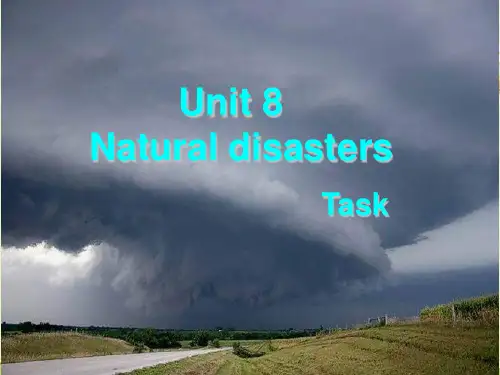
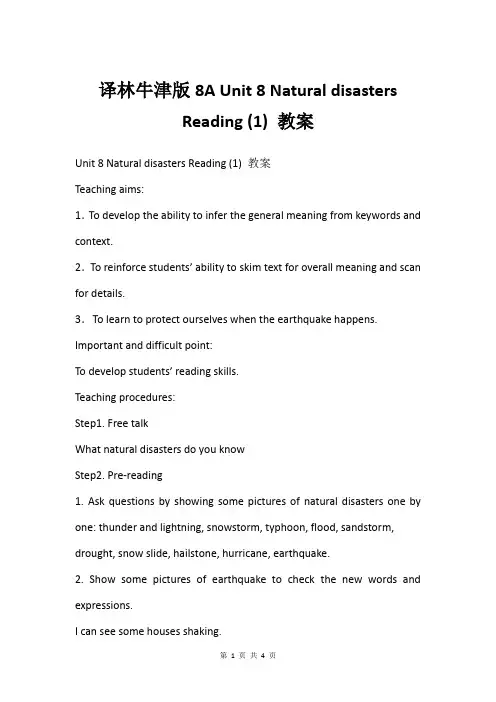
译林牛津版8A Unit 8 Natural disastersReading (1) 教案Unit 8 Natural disasters Reading (1) 教案Teaching aims:1.To develop the ability to infer the general meaning from keywords and context.2.To reinforce students’ ability to skim text for overall meaning and scan for details.3.To learn to protect ourselves when the earthquake happens. Important and difficult point:To develop students’ reading skills.Teaching procedures:Step1. Free talkWhat natural disasters do you knowStep2. Pre-reading1. Ask questions by showing some pictures of natural disasters one by one: thunder and lightning, snowstorm, typhoon, flood, sandstorm, drought, snow slide, hailstone, hurricane, earthquake.2. Show some pictures of earthquake to check the new words and expressions.I can see some houses shaking.I can see pieces of glass and bricks falling down.I can see walls coming down.I can see people running in all directions.I can hear a loud noise like a bomb.I can hear some people screaming.3. Matching some other new words and phrases.Step3. While-reading1. Skimming(1).Ask: Can you give us another title to replace ‘The Taiwan earthquake ’(2).Let the students divide the passage.Para(s) ___: The earthquake came.Para(s) ___: Timmy was trapped.Para(s) ___: Timmy was safe.2. Scanning(1). Read paras 1-2 to fill in the table.When the earthquake came, what did Timmy …feelhearseedo(2). Read paras 3-4 to answer 5 ‘T/F’ questions.1. He could not see anything at all.2. He felt nervous and his head was beating fast.3. A moment of fear went through his body.4. He shouted for help, but no one came.5. He started to pull himself quickly through the dark.(3). Read para 5 to answer 2 questions.1. What did people do to help him out2. What did he see at last(4).Rearrange partB2 on page 95 into correct order.Step4 .Post-readingFinish a story entry.Li Dan is a girl. She lives in Wenchuan. She survived the e_________ in 2023. She was shopping when she heard a loud noise.It was like the noise of t______. Then the noise became really loud. It sounded like b_____ under the ground. After that, pieces of glass and b____ fell down.When the noise ended, she was t______ and could not see anything at all. A moment of f____ went through her mind. Then she tried to c____ down and s_______ for help. Finally, people moved away the bricks and stones and saved her.Step5. Group work.Discuss: What should we do in an earthquakeStep6. Conclusion.What should we do in an earthquake \If you are trapped in the earthquake, you should:calm downtry to find your way outshout for help3. We should protect the earth, protect the environment. Step7. Homework.1. Write a report about Timmy.2. Retell Timmy’s story with your own words.1。
牛津译林版八年级上册Unit 8《Natural disasters》(Task)教学设计一. 教材分析牛津译林版八年级上册Unit 8《Natural disasters》主要介绍了自然灾害,包括地震、洪水、台风等,通过学习本单元,学生可以掌握有关自然灾害的词汇和表达方式,了解自然灾害发生的原因及应对措施。
Task部分要求学生阅读一篇关于自然灾害的文章,然后进行相关练习,培养学生的阅读能力和解决问题的能力。
二. 学情分析八年级的学生已经具备了一定的英语基础,能够进行简单的阅读和交流。
但部分学生在阅读长篇文章时,可能会遇到生词和语法难题,影响阅读理解。
此外,学生对于自然灾害的了解程度不一,需要教师在教学中进行引导和补充。
三. 教学目标1.知识目标:学生能够掌握有关自然灾害的词汇和表达方式,了解自然灾害发生的原因及应对措施。
2.能力目标:学生能够阅读并理解关于自然灾害的文章,提高阅读能力;通过任务型教学,培养学生的解决问题能力。
3.情感目标:培养学生关爱生命,关注自然的意识,提高学生应对自然灾害的能力。
四. 教学重难点1.重点:学生能够掌握有关自然灾害的词汇和表达方式,阅读并理解关于自然灾害的文章。
2.难点:学生能够运用所学知识,解决实际问题,提高应对自然灾害的能力。
五. 教学方法1.任务型教学法:通过任务型教学,让学生在实践中掌握知识,提高能力。
2.情境教学法:创设情境,让学生在真实的环境中学习,提高学生的学习兴趣。
3.合作学习法:引导学生进行小组合作,培养学生的团队精神和沟通能力。
六. 教学准备1.教师准备:提前准备关于自然灾害的文章,整理相关词汇和表达方式,设计任务型练习。
2.学生准备:预习课文,了解自然灾害的基本知识,准备参与课堂活动。
七. 教学过程1.导入(5分钟)教师通过提问方式引导学生谈论自然灾害,激发学生的学习兴趣。
例如:“你们知道哪些自然灾害?它们发生的原因是什么?”2.呈现(10分钟)教师呈现关于自然灾害的文章,让学生快速阅读,了解文章大意。
Unit 8 Natural disasters Task 教案学习目标单词:nearly, sandstorm , warning短语:share…with…, snowstorm warning, forget to bring my keys, continue to fall, fall over,能够用第一人称写一篇自己所亲历的自然灾害的文章。
学习重点1.按事件发展的顺序列出有关自然灾害及对人类影响的事实性性信息。
2. 通过事实性性信息画流程图来构思文章。
学习难点写一篇有关自然灾害的文章课前自学一.翻译下列短语.1. share an umbrella with sb.2.the noise of traffic3.慢慢地走4.继续下(雪)5.铲除雪6.去米莉家7.snowstorm warning 8.forget to bring keys9.暴风雪袭击北京10.最终二.预习课本102-103页的内容,将Part B部分的内容先填好,并了解写作的方法。
三.为写一篇关于自然灾害的文章想好主题,知道大概写什么。
释疑展示一:在组内和班内展示课前自学的重要知识点.展示二:(1). 以小组为单位,对Sandy所经历的暴风雪的信息进行提问。
1. When did the snowstorm hit Beijing?2. Who did Sandy share an umbrella with?3. Where did Sandy live in for the whole night?4. How did Sandy feel the snowstorm?(2).快速阅读A部分,并用A部分的信息完成B部分的填空。
讨论展示(3).小组合作,完成段落与其大意的搭配,各小组展示Para. _______ IntroductionPara. _______ During the snowstormPara. _______ After the snowstorm反馈1.回忆曾经经历的或通过电视,报纸等所知道的自然灾害,把信息记录在笔记本上,并画一张类似B 部分的流程图.然后再一篇文章。